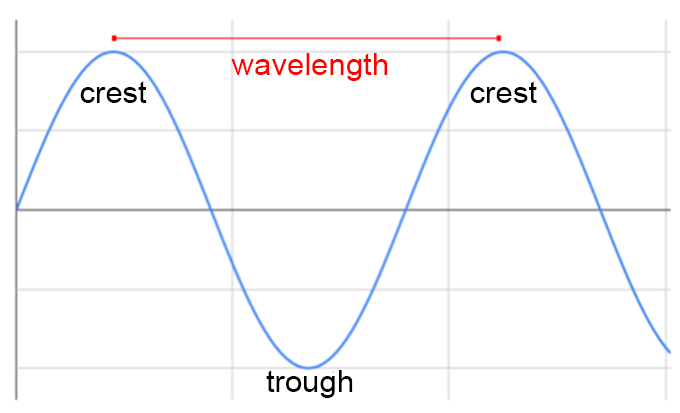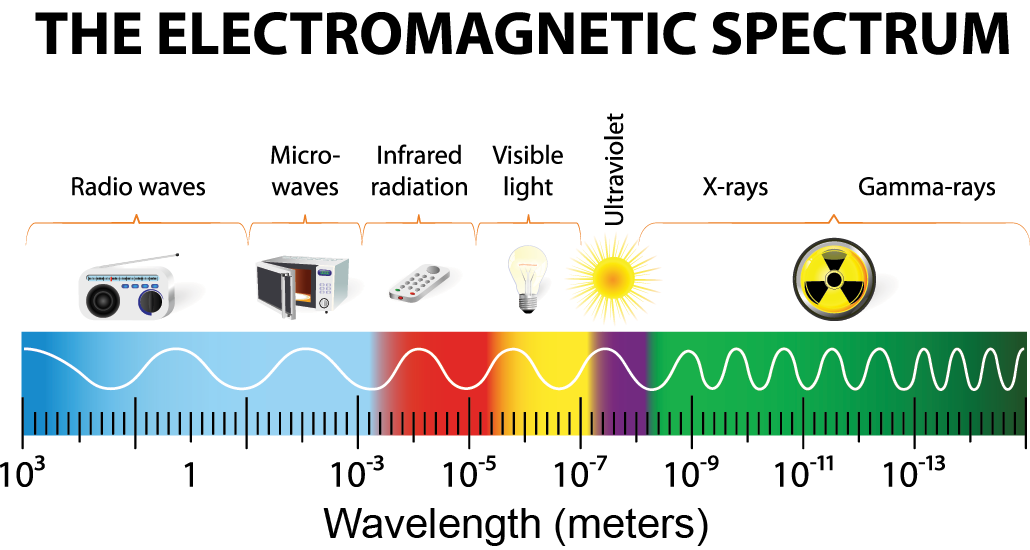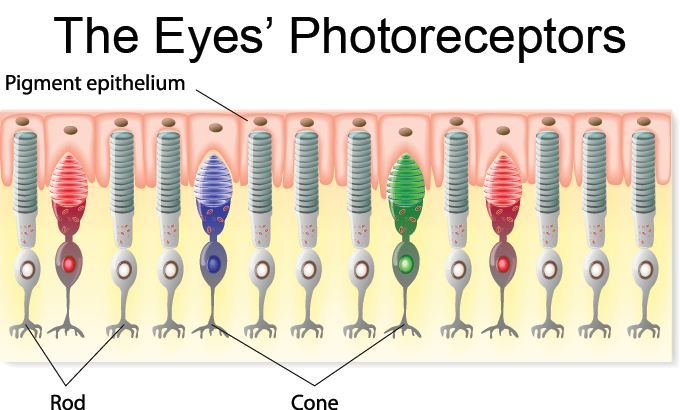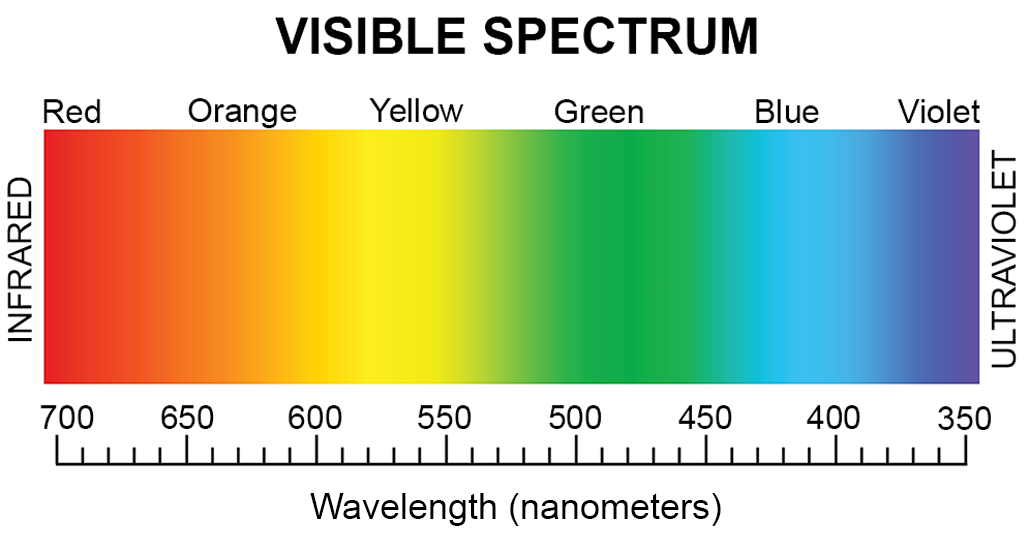紫色只存在于我们的大脑中:大脑如何“创造” Purple
Purple exists only in our brains
这个颜色是我们的大脑为了解决一个难题而产生的。

这些食物中的紫色——以及其他一切事物中的紫色——并不是可见光谱的一部分。那么我们是如何以及为什么看到它的呢?我们将进行解释。
VICUSCHKA/Moment/Getty Images Plus
Share this:
By Tammy Awtry January 28, 2025 at 6:30 am
紫色这种颜色有些独特之处:它是由我们的大脑创造出来的。所以你可能会说紫色是我们想象力的产物。
这也是一个有趣的例子,说明当大脑面临系统错误时,是如何创造出美丽的事物的。
Understanding light and other forms of energy on the move
为了理解紫色的来源,我们需要了解我们的眼睛和大脑是如何协同工作来感知颜色的。而这一切都始于光。
光是电磁辐射的另一种说法。大多数光来自太阳,并以波的形式传播到地球。有许多不同类型的光,科学家根据这些波的长度对其进行分组。(波长是指一个波峰和下一个波峰之间的距离。)所有这些波长共同构成了电磁光谱。

光以波的形式移动其能量(蓝色线条所示),上下移动。这产生了称为波峰的高点和称为波谷的低点。光的波长(即一个波峰到另一个波峰或一个波谷到另一个波谷的距离)各不相同。J. LOOK
我们的眼睛无法看到大多数波长,例如用于烹饪食物的微波或在不涂防晒霜时会灼伤我们皮肤的紫外线。我们只能直接看到光谱中非常非常小的一部分——仅占 0.0035%!这一小部分被称为可见光光谱。它的波长范围约为 350 到 700 纳米。
首字母缩写 ROYGBIV(发音为 Roy-gee-biv)可用于记住可见光谱中颜色的顺序:红、橙、黄、绿、蓝、靛、紫 (red, orange, yellow, green, blue, indigo and violet)。你可以在雨后天空中出现的彩虹中看到这些颜色,或者当光线穿过棱镜时也可以看到。在可见光谱中,红光具有最长的波长。蓝色和紫色是最短的。绿色和黄色位于中间。
虽然紫色 (violet) 位于可见光谱中,但 purple 却不在。实际上,紫色 (violet) 和 purple 不是 同一种颜色。它们看起来很相似,但我们的大脑感知它们的方式却大不相同。

电磁光谱包含所有类型的光。我们的眼睛只能看到这个广阔光谱中的一小部分,这里标记为可见光。ttsz/iStock/Getty Images Plus
我们如何看到颜色
颜色感知始于我们的眼睛。我们眼睛的后部包含称为视锥细胞的感光细胞。大多数人有三种类型。它们有时被称为红色、绿色和蓝色视锥细胞,因为每种视锥细胞对其中一种颜色最敏感。
但是视锥细胞不会“看到”颜色,Zab Johnson 指出。相反,它们会检测特定波长的光。
Explainer: How our eyes make sense of light
Johnson 在费城的宾夕法尼亚大学工作。她和其他研究我们如何感知颜色的科学家更喜欢根据视锥细胞检测到的波长范围对其进行分类:长、中或短。
所谓的红色视锥细胞检测长波长的光。绿色视锥细胞对可见光谱中间的光反应最强烈。蓝色视锥细胞最能检测到可见光谱较短端的波长。

这是视网膜背面的插图,其中充满了视杆细胞和视锥细胞。视杆细胞又长又直。它们对光非常敏感,可以帮助我们在黑暗中看到东西。我们的眼睛拥有的视锥细胞较少,它们对颜色敏感。色素上皮是光感受器下方的深色细胞层。它们吸收多余的光线。ttsz/iStock/Getty Images
当光线进入我们的眼睛时,它激活的特定视锥细胞组合就像一个代码。我们的大脑会破译该代码,然后将其转换为颜色。
考虑一下刺激长波和中波视锥细胞但很少或没有刺激短波视锥细胞的光线。我们的大脑将其解释为橙色。当光线主要触发短波视锥细胞时,我们看到蓝色或紫色 (violet)。中波和短波视锥细胞的组合看起来是绿色。可见彩虹中的任何颜色都可以通过单波长的光刺激特定组合的视锥细胞来创建。

可见光谱是我们眼睛可以检测到的光波长范围。Olena Poliakevych/iStock/Getty Images Plus
请注意,可见光谱是一个渐变。一种颜色逐渐过渡到下一种颜色。光激活的视锥细胞的活动也从一种类型逐渐转移到另一种类型。例如,在光谱的红色端,长波视锥细胞完成大部分工作。当您从红色移动到橙色时,中波视锥细胞的帮助更大,而长波视锥细胞的工作更少。
在彩虹的中间——像绿色和黄色这样的颜色——中波视锥细胞最繁忙,同时得到长波和短波视锥细胞的帮助。在光谱的蓝色端,短波视锥细胞完成大部分工作。
但是,光谱上没有任何颜色是通过组合长波和短波视锥细胞而产生的。

Educators and Parents, Sign Up for The Cheat Sheet
每周更新,帮助您在学习环境中使用 Science News Explores Client key* E-mail Address* Go Thank you for signing up! There was a problem signing you up.
那么 purple 来自哪里?
这使 purple 成为了一个难题。
Purple 是红色(长波)和蓝色(短波)波长的混合。看到 purple 的东西,如茄子或丁香,会同时刺激短波和长波视锥细胞。这会使大脑感到困惑。如果长波视锥细胞受到激发,颜色应该是红色或接近红色。如果短波视锥细胞受到激发,颜色应该接近蓝色。
问题是:这些颜色位于光谱的相对两端。一种颜色怎么可能同时接近两端?
为了应对,大脑进行了即兴创作。它获取可见光谱——通常是一条直线——并将其弯曲成一个圆圈。这会将蓝色和红色彼此相邻放置。
仅仅是一种错觉

T. Awtry
大脑弯曲可见光谱,使红色和蓝色相邻。然后,它添加 purple 以创建一个色轮。
“蓝色和红色应该位于线性刻度的相对两端,”Johnson 解释说。“然而,在某个时候,蓝色和红色开始聚集在一起。而这个聚集点被称为 purple。”
我们的大脑现在将可见光谱重新塑造成一个色轮,并插入一系列 purple ——实际上并不存在——作为一种解决方案,以解释为什么它会收到来自可见光谱相对两端的信息。
属于可见光谱一部分的颜色被称为光谱颜色。我们的大脑只需要一个波长的光就可以感知每种颜色的阴影。然而,Purple 是一种_非光谱_颜色。这意味着它由两个波长的光(一个长波和一个短波)组成。
这就是紫色 (violet) 和 purple 之间的区别。紫色 (violet) 是一种光谱颜色——可见光谱的一部分。Purple 是一种非光谱颜色,是大脑为了理解令人困惑的信息而创造的。
当我们说 purple 实际上并不存在时,我们是什么意思?
因此,Purple 源于我们处理光线方式的一个独特之处。这是一个美丽的例子,说明当我们的脑海遇到异常情况时会如何反应。但 Anya Hurlbert 说,并非只有 Purple 这种颜色值得我们赞赏。
“所有的颜色都是由大脑构成的。句号,”这位英国纽卡斯尔大学的视觉科学家说。它们是大脑解释我们眼睛信号的方式。而且它们为我们感知的事物增添了如此多的意义,她说。
“瘀伤的颜色告诉我它有多旧。水果的颜色告诉我它有多成熟。一块布料的颜色告诉我它是已经洗过很多次还是刚从生产线下来的,”她说。“几乎没有其他东西是从如此简单的事情(如光波长)开始,最终却如此深刻和丰富。”
您有科学问题吗?我们可以提供帮助!
在此处提交您的问题,我们可能会在即将发行的 Science News Explores 中回答它
Power Words
acronym : A word made by combining some of the starting letter or groups of letters from a number of words. For instance, STEM is an acronym for Science, Technology, Engineering and Math. Radar is an acronym for RAdio Detection And Ranging. Even laser is an acronym for Light Amplification by Stimulated Emission of Radiation. activate : (in biology) To turn on, as with a gene or chemical reaction. cell : (in biology) The smallest structural and functional unit of an organism. Typically too small to see with the unaided eye, it consists of a watery fluid surrounded by a membrane or wall. cones : (in biology) A type of eye cell that is part of the retina inside the back of the eye. These cells can sense red, green or blue light. Recent research has uncovered evidence that many can sense white light — but only white light. electromagnetic : An adjective referring to light radiation, to magnetism or to both. electromagnetic radiation : Energy that travels as a wave, including forms of light. Electromagnetic radiation is typically classified by its wavelength. The spectrum of electromagnetic radiation ranges from radio waves to gamma rays. It also includes microwaves and visible light. electromagnetic spectrum : The range of radiation that spans from gamma- and X-rays through visible light and on to radio waves. Each type of radiation within the spectrum typically is classified by its wavelength. gradient : From the word “grade,” it describes the incline, slope or degree of increase in some measure (such as temperature, pressure or even color) that develops as one moves in time, position or along some scale. microwaves : An electromagnetic wave with a wavelength shorter than that of normal radio waves but longer than those of infrared radiation (heat) and of visible light. nanometer : A billionth of a meter. It’s such a small unit that researchers use it as a yardstick for measuring wavelengths of light or distances within molecules. For perspective, an average human hair is about 60,000 nanometers wide. perception : The state of being aware of something — or the process of becoming aware of something — through use of the senses. pigment : A material, like the natural colorings in skin, that alter the light reflected off of an object or transmitted through it. The overall color of a pigment typically depends on which wavelengths of visible light it absorbs and which ones it reflects. For example, a red pigment tends to reflect red wavelengths of light very well and typically absorbs other colors. Pigment also is the term for chemicals that manufacturers use to tint paint. prism : A triangular wedge of glass or another clear substance that can bend the components of white light into a rainbow-like succession of colored bands. (v.) To separate light into its component hues. radiation : (in physics) One of the three major ways that energy is transferred. (The other two are conduction and convection.) In radiation, electromagnetic waves carry energy from one place to another. Unlike conduction and convection, which need material to help transfer the energy, radiation can transfer energy across empty space. range : The full extent or distribution of something. For instance, a plant or animal’s range is the area over which it naturally exists. spectrum : (plural: spectra) A range of related things that appear in some order. (in light and energy) The range of electromagnetic radiation types; they span from gamma rays to X rays, ultraviolet light, visible light, infrared energy, microwaves and radio waves. system : A network of parts that together work to achieve some function. For instance, the blood, vessels and heart are primary components of the human body's circulatory system. Similarly, trains, platforms, tracks, roadway signals and overpasses are among the potential components of a nation's railway system. System can even be applied to the processes or ideas that are part of some method or ordered set of procedures for getting a task done. ultraviolet light : A type of electromagnetic radiation with a wavelength from 10 nanometers to 380 nanometers. The wavelengths are shorter than that of visible light but longer than X-rays. unique : Something that is unlike anything else; the only one of its kind. visible light : A type of electromagnetic radiation with wavelengths that range between 380 nanometers (violet) and 740 nanometers (red). Visible light has wavelengths that are shorter than infrared light, microwaves, and radio waves but longer than ultraviolet light, X-rays and gamma rays. wave : A disturbance or variation that travels through space and matter in a regular, oscillating fashion.wavelength : The distance between one peak and the next in a series of waves, or the distance between one trough and th next. It’s also one of the “yardsticks” used to measure radiation. Visible light — which, like all electromagnetic radiation, travels in waves — includes wavelengths between about 380 nanometers (violet) and about 740 nanometers (red). Radiation with wavelengths shorter than visible light includes gamma rays, X-rays and ultraviolet light. Longer
Citations
Website: National Nuclear Security Administration. Visible Light: Eye-opening research at NNSA. October 17, 2018.